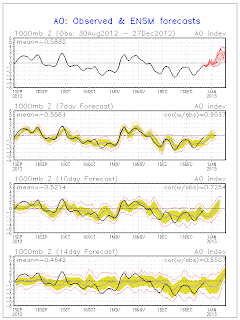Though Northern Valley snow still remains a challenge and uncertain, there is certainty that the Northern Shasta, Northern Trinity and Southern Siskiyou mountains will see a tremendous amount of snow.
The image above is the 5-day QPF (Quantitative Precipitation Forecast) from the NWS. Basically this means if everything that were to fall in the form of liquid or if you converted it to rain this is how much precipitation you could expect. And as you can see Northern Shasta, Southern Siskiyou county get painted with 7-8" of liquid. Forecast rain-to-snow ratios are right around 1:11" averaged out for the entire event. So you're talking 77-88" of snow. This is likely overdone but fascinating none the less.
As you can see HPC is also leaning between 7-9" of QPF too.
Here is the 72 hour snowfall accumulation map. Unfortunately it only goes out until 10:00am Saturday. But right in that bullseye I showed you above you can see where our in-house model is picking up 60-72" of snow in the Mount Shasta City area through Saturday morning, not including the rest of Saturday's or Sunday storm too.
HOW ABOUT THE VALLEY?
This is the million dollar question. In the last 18 hours, forecast models have drastically slowed down the initial storm. This will play a major role in the chances for valley snow.
At 5:00 am Thursday morning there is actually quite the clearing on the forecast Satellite over Redding. So we could see some decent radiational cooling.
By 8:00am Thursday morning you can see some decent cloud cover has moved over about Red Bluff and North. So maybe enough cloud cover to lock the cold air in place.
The Biggest challenge of the Forecast is the winds. We are expecting strong south winds for most of the valley. IF the winds make it into Redding then our chances for accumulating snow are greatly reduced to near 0.
Here some forecasts of the winds tomorrow morning.
As of 11:30 tomorrow morning the strong south winds are south and southeast of Redding, unable to penetrate the cold air-mass.
The rest of the day the winds try to increase near Redding but still the south winds are not as strong as the winds south and southeast of Redding.
The image above is the Forecast Skew T sounding for Redding at 10:00 am tomorrow morning. The surface air column is still not fully saturated. But the 0-degree wet bulb height is 377ft, which means that at that time if enough precipitation were to fall it would be 32 degrees F or 0 degrees C at 377ft elevation. *****The wet bulb temperature is the temperature the air would fall to at full saturation (through evaporative cooling) However models continue to show precipitation not moving in until after 12:00pm.
By 1:00pm you can now see that air still not fully Saturated and the 0-degree Wet Bulb temperature has now risen to over 1300 ft.
Just because it is not freezing at the surface (Redding's elevation is between 500-900ft) doesn't mean and can't snow. Redding this past Saturday saw several hours of snow with a temperature of 34 degrees. Also if the precipitation is hard enough it can bring the cold air down with it and not have enough time to melt. So overall it appears that for Redding to see snow the earlier the better, which hasn't been in our favor the last few model runs and we are running out of time.
At 8:30 Thursday evening you can see that the rain/snow line is hovering right on or just slightly north of Redding.
That's what makes this forecast so difficult because the rain/snow line is going to hover right over Redding through tomorrow evening, tomorrow night. Eventually Redding will switch over to rain, washing away any accumulations that we could possibly see.
Stay tuned, things seem to change from one model run to another.








.gif)






















